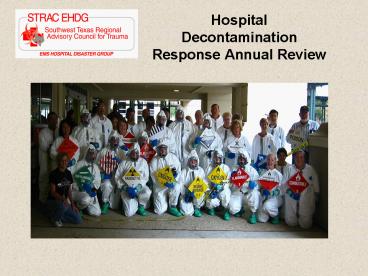Hospital Decontamination Response Annual Review - PowerPoint PPT Presentation
1 / 19
Title:
Hospital Decontamination Response Annual Review
Description:
Have patient remove all valuables and clothing ... Remove their Level C PPE suit and clothes. Perform assisted decon. Triage and treat ... – PowerPoint PPT presentation
Number of Views:143
Avg rating:3.0/5.0
Title: Hospital Decontamination Response Annual Review
1
Hospital Decontamination Response Annual Review
2
What is decontamination?
- While it has many definitions, it is a method for
cleaning off contaminated patients - Decontamination reduces and prevents the spread
of hazardous agents to employees and within the
facility
3
Hazardous Agents
- According to OSHA Any substance to which
exposure results or may result in adverse
affects on the health or safety of employees or
any chemical which is a physical hazard or a
health hazard. OSHA 29 CFR 1910.120 (a)
4
How do you know if a patient has been exposed?
- Obvious physical signs and symptoms of hazardous
agent exposure - Liquids or powders on the patient
- Odors emanating from the patient
- Difficulty breathing
- Burns, blisters
- Foaming at the mouth or tearing
- Emesis, defecation, urination
5
Methods of detectionCHEMICAL
- Nerve Agents
- Blister Agents
- Blood Agents
- Choking Agents
- Irritant Agents
- Smart Strips - Changes colors when exposed to
chlorine, pH, fluoride, nerve agents, oxidizers,
arsenic, sulfides and cyanide in liquid or
aerosol form at minute levels. To use,
peel-and-stick adhesive strip or a clip to decon
suit. Once the protective film is peeled off, the
cards are operational for 12 hours, or until they
are exposed to one of the eight substances.
6
Methods of detection RADIOLOGICAL
- Alpha particles (common) - most harmful if
inhaled or ingested. These can be stopped by a
sheet of paper - Beta particles - smaller than alpha and stopped
by regular PPE - Personal Pocket Dosimeter
- Detects Beta and
- X-ray Radiation
- Ludlum detects Alpha, Beta and Gamma radiation
7
If a contaminated person presents to the
hospital, what do you do? PIN
- P Protect
- standard precautions
- Do not touch the patient or allow anyone else to
have patient contact without at least an N-95
mask and gloves - I Isolate
- Get the contaminated patient out of the ED to a
pre-designated location - Isolate the exposed scene (Triage desk, ED
hallway) and deny entry - N Notify
- Notify your Supervisor that a contaminated
patient has arrived at the facility - If needed, call Security to secure the area
- Work with your Supervisor to determine your
facilitys need to activate the DRT or initiate
disaster response procedures
8
Hospital Decontamination Zone
9
Control Zones Contamination Reduction Corridor
HOT Site Access Control START Triage
- Contaminated Area HOT
- Area of isolation
- MUST use appropriate hazardous agent PPE
- Hospital Decontamination Zone WARM
- Area where decontamination activities take place
- MUST use appropriate hazardous agent PPE
- Hospital Post-Decontamination Zone COLD
- Safe area
- Use Standard Precautions
Decon Setup Stripper/Bagger WARM
Decon Support Washer/Rinser
Decon Support Dryer / Dresser Hospital
Gatekeeper COLD
10
Setup of Decon Operations
- Establish Decontamination Zone
- Access decontamination supplies
- Assemble the decontamination shelter and adjunct
equipment - Ensure access to contaminated waste for ease of
removal during decon operations - EPA requires run-off be contained if at all
possible for proper disposal
11
Directed Decon
- Appropriate for conscious and ambulatory patients
- Directed decon can be performed by small numbers
of contaminated patients - Protect yourself first
- May require employing Standard Precautions
- May require use of hazardous agent PPE
- Maintain patient modesty
12
Process for Performing Directed Decon
- Have patient remove all valuables and clothing
- Place contaminated valuables and clothing in a
sealable bag - Starting from the head down, have patient
- Wash body with soap and warm water for 5 minutes
- Rinse body with warm water for 5 minutes
- Have patient dry their body
- Provide patient with a clean covering
- Re-evaluate patient
13
Duties of DRT Members in the Hospital Post-Decon
Zone
- Evaluation of decontamination efforts
- Re-triage
- Begin patient tracking
- Transport to patient care areas
14
Level C PPE
- Provides a lower level of skin and respiratory
protection - Liquid splash protection suit with or without a
hood (chemical resistant) - Air-Purifying Respirator (filters vary)
- Chemical resistant gloves and boots
- Weakness bulky, heavy, increased potential for
heat stress and slip, trip or fall injuries and
may not reduce exposure to all agents
15
Risks of Hazardous Agent PPE
- Incorrect use or improper selection
- Penetration into the PPE (holes/rips)
- Slips, trips and falls
- Loss of dexterity
- Heat-related illness
- Heat Exhaustion
- Heat Stroke
16
Donning PPE
- Work with a Buddy!
- Put on
- Inner Gloves
- Tychem BR Suit
- PVC Boot Covers o7 chemical resistant rubber
boots - Outer Gloves
- Duct Tape around glove and boot openings and suit
zipper - Respirator if using APR duct tape seal
17
The last patient has been decontaminated, now
what?
- Decon Response Team must now decon themselves in
their PPE and then the equipment - Once in the Post-Decontamination Zone, DRT
members can doff PPE
18
Doffing PPE
- Work with a Buddy!
- For speed, cut with scissors and peel off or
- Take off
- Duct tape at suit and glove seals
- Outer gloves
- Peel suit away from body
- PVC boot covers
- Respirator
- Inner gloves
19
What do you do if one of the DRT Members go
down?
- If one of the team becomes a patient
- Remove them from their post
- Remove their Level C PPE suit and clothes
- Perform assisted decon
- Triage and treat

